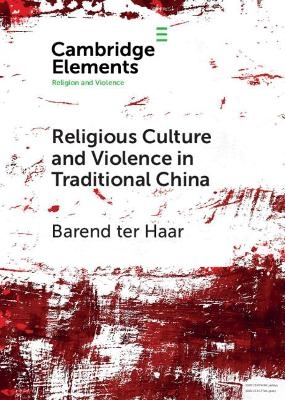
Religious Culture and Violence in Traditional China
Seiten
2019
Cambridge University Press (Verlag)
978-1-108-70623-0 (ISBN)
Cambridge University Press (Verlag)
978-1-108-70623-0 (ISBN)
Summarizes the most important aspects of the role of violence in Chinese religious culture. These include counteracting the threat and fear of demonic attacks, maintaining norms and values, and expressing respect through sacrificial gifts of meat. Explores how violence was justified as positive use of physical force.
The basis of Chinese religious culture, and with that many aspects of daily life, was the threat and fear of demonic attacks. These were inherently violent and could only be counteracted by violence as well - even if this reactive violence was masked by euphemisms such as execution, expulsion, exorcisms and so on. At the same time, violence was a crucial dimension of the maintenance of norms and values, for instance in sworn agreements or in beliefs about underworld punishment. Violence was also an essential aspect of expressing respect through sacrificial gifts of meat (and in an earlier stage of Chinese culture also human flesh) and through a culture of auto-mutilation and ritual suicide. At the same time, conventional indigenous terms for violence such as bao 暴 were not used for most of these practices since they were not experienced as such, but rather justified as positive uses of physical force.
The basis of Chinese religious culture, and with that many aspects of daily life, was the threat and fear of demonic attacks. These were inherently violent and could only be counteracted by violence as well - even if this reactive violence was masked by euphemisms such as execution, expulsion, exorcisms and so on. At the same time, violence was a crucial dimension of the maintenance of norms and values, for instance in sworn agreements or in beliefs about underworld punishment. Violence was also an essential aspect of expressing respect through sacrificial gifts of meat (and in an earlier stage of Chinese culture also human flesh) and through a culture of auto-mutilation and ritual suicide. At the same time, conventional indigenous terms for violence such as bao 暴 were not used for most of these practices since they were not experienced as such, but rather justified as positive uses of physical force.
Preface; 1. Setting the stage; 2. What is violence?; 3. The demonological substrate; 4. Messianic and millenarian traditions; 5. The enforcement of norms and social values; 6. Sacrifice and its counter-discourse; 7. Self-inflicted violence; 8. Intra-religious conflicts; Concluding comments.
| Erscheinungsdatum | 02.08.2019 |
|---|---|
| Reihe/Serie | Elements in Religion and Violence |
| Zusatzinfo | Worked examples or Exercises |
| Verlagsort | Cambridge |
| Sprache | englisch |
| Maße | 128 x 180 mm |
| Gewicht | 1200 g |
| Themenwelt | Geschichte ► Allgemeine Geschichte ► Altertum / Antike |
| Geisteswissenschaften ► Religion / Theologie ► Weitere Religionen | |
| ISBN-10 | 1-108-70623-1 / 1108706231 |
| ISBN-13 | 978-1-108-70623-0 / 9781108706230 |
| Zustand | Neuware |
| Haben Sie eine Frage zum Produkt? |
Mehr entdecken
aus dem Bereich
aus dem Bereich
die Inszenierung der Politik in der römischen Republik
Buch | Hardcover (2023)
C.H.Beck (Verlag)
48,00 €


